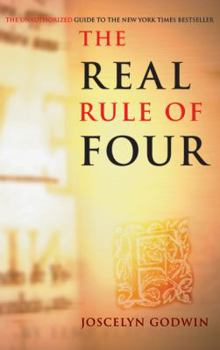The Real Rule of Four: The Unauthorized Guide to the New York Times #1 Bestseller
Discusses the historical and intellectual background of the novel The Rule of Four, examining the 1499 Renaissance text that forms the central theme of the novel. This description may be from another edition of this product.
Format:Paperback
Language:English
ISBN:1932857087
ISBN13:9781932857085
Release Date:November 2005
Publisher:Disinformation Books
Length:208 Pages
Weight:0.50 lbs.
Dimensions:7.0" x 0.5" x 5.3"
Customer Reviews
3 ratings
A Magnificent Guide
Published by Thriftbooks.com User , 19 years ago
Any best-seller nowadays can be expected to generate a side industry of books, films, computer games, plastic toys and so on, trying to capitalize on the success of the original. It would be a great mistake, however, to dismiss Joscelyn Godwin's magnificent guide as just a spin-off from the success of the Rule of Four. For one thing, its author not only follows but also preceded the novel, because as author of the only modern English translation of Francesco Colonna's Hypnerotomachia Poliphili he provided the best source of knowledge of the inspiration for the Rule of Four available to people who don't read mediaeval Italian. It would have been easy, and perhaps tempting, for a scholar of Godwin's knowledge and ability to be patronizing about the Rule of Four, concentrating on correcting its errors and misinterpretations and on displaying his own superior understanding of the Hypnerotomachia, but Godwin does not do that. On the contrary, his attitude to the novel is thoroughly generous and positive. He starts by assuring us that the Hypnerotomachia is a real book, not a fictional invention of Ian Caldwell and Dustin Thomason, explains its importance in the history of typography and erotic literature, and describes what it is all about. He goes on to analyse the structure -- unusually complex for a popular novel -- of the Rule of Four, and to examine the evidence for the identity of the real author of the Hypnerotomachia. In this his conclusion is different from that reached in the Rule of Four, but he does not dismiss other possibilities as absurd. He describes the historical context in which the Hypnerotomachia was written, including the famous "bonfire of the vanities" of Savonarola. Finally he analyses what the Hypnerotomachia is really all about, and explains all the literary, historical and geographical name-dropping that occurs in the Rule of Four. All in all, this is an indispensable guide, written by an outstanding expert, for anyone interested in reading the Rule of Four in more than the most superficial way.
Interesting Introduction to a Strange Work
Published by Thriftbooks.com User , 19 years ago
Joscelyn Godwin has published a number of excellent books, the most important of which is probably his first ever English translation of the famous and mysterious Renaissance epic, the "Hypnerotomachia Poliphili". This book, with its clouded origins and hidden meaning, forms the basis of the novel "The Rule of Four" which has managed to work itself onto bestseller lists on the coattails of "The Da Vinci Code", though its obscure esocteric subject is much less controversial. Here Godwin explores the origins and authorship of the "Hypnerotomachia" in detail for the layreader and provides much interesting insight into this most beautiful and strange book. The "Hypnerotomachia" was published in Venice by the famous Renaissance humanist printer Aldus Manutius in 1499 and has intrigued and confounded readers and scholars alike for 500 years. Godwin first gives an overview of the book's plot and discusses the 172 beautiful woodcut engravings that have made the book so fascinating to five centuries of readers. The book is filled with long and painstakingly detailed descriptions of architecture, statues, parades, ruins, pagan rituals, and beautiful, ethereal, naked nymphs and goddesses. In fact, it is this rather blatant erotic element that has certainly helped to make the book so popular. This scandalous aspect of the book made it so popular in fact, that today it is almost impossible to find original copies with all of its engravings intact or without censorship. Godwin also discusses at length the controversy regarding the authorship of the tome, today largely accepted by scholars and historians as the Venetian monk Francesco Colonna. "The Rule of Four", Godwin points out, makes great use of fictional elements of the famous book, inventing codes and ciphers that are reputed to hide secret knowledge in its voluminous pages. Godwin emphasizes that despite these fictional inventions that help make "The Rule of Four" entertaining, the real Hypnerotomachia is just as interesting without them. Godwin has written an engaging and accessible book on a difficult and bizarre work. He has helped to clear up many of the mysteries that have clouded the famous book and its author and given fans of "The Rule of Four" more detail and information on the events, places, and people found in that novel. This book is a must for anyone who enjoyed "The Rule of Four" and is looking to delve deeper into the strange world of Poliphilo and his dream quest for the elusive Polia.
Brilliant
Published by Thriftbooks.com User , 20 years ago
Perhaps Professor Godwin ought to have written the novel himself! Certainly, by translating into English the entire text of the "Hypnoerotomachia Poliphilli", he was the condicio sine qua non for "The Rule of Four". I recommend this guide wholeheartedly, it is brilliant.





